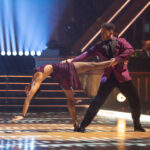When Dancing with the Stars premiered, it quickly became a cultural phenomenon. While many remember the later seasons with their heightened production values and celebrity contestants, it’s essential to look back at the early days, particularly Dancing With The Stars Season 2, to appreciate the show’s evolution and the stars who paved the way. One such star is Drew Lachey, who, alongside professional partner Cheryl Burke, charmed audiences and ultimately clinched the Mirrorball Trophy in season 2.
To truly understand Drew Lachey’s journey on the All-Stars season (Season 15), it’s crucial to revisit his original run in dancing with the stars season 2. Let’s delve into what made Drew’s season 2 performance so memorable, examining his best and perhaps not-so-best moments, and reflect on how the show itself has changed since those early days.
Drew’s journey on dancing with the stars season 2 was marked by consistent improvement and a captivating stage presence. While pinpointing his absolute “best” dance is subjective, his Paso Doble to “Thriller” stands out as a defining moment. This routine perfectly encapsulated Drew’s ability to blend technical skill with showmanship, a quality that resonated deeply with viewers and judges alike.
[Insert Image 1]
This “Thriller” Paso Doble wasn’t just technically proficient for that era of the show; it was also incredibly entertaining and showcased Drew’s commitment to performance. It highlighted his strengths: a strong sense of rhythm, a willingness to fully embody each character, and a clear connection with Cheryl Burke.
However, every journey has its bumps. Looking back at dancing with the stars season 2, Drew and Cheryl’s Week 1 Cha-Cha offers a glimpse into the initial learning curve. While not a disastrous performance, it lacked the polish and confidence that would define his later dances.
[Insert Image 2]
In this early Cha-Cha, Drew appears slightly hesitant, particularly in his hand movements. This initial awkwardness, however, underscores his growth throughout dancing with the stars season 2. It’s a reminder that even eventual champions start somewhere, and Drew’s journey was one of noticeable and admirable progress.
Reflecting on dancing with the stars season 2 in the context of later seasons, it’s evident how much the show’s overall dance quality has evolved. Even comparing Drew’s winning performances to contestants from just a few seasons later, the technical demands and choreography complexity have increased significantly. This isn’t a criticism of the early seasons, but rather an observation of the show’s natural progression and the increasing caliber of talent it attracts.
For Drew, returning for the All-Stars season meant bridging that gap. While he possessed a strong foundation from his dancing with the stars season 2 win, the landscape of the competition had shifted. Contestants like Joey Fatone and Gilles Marini, who competed in later seasons, brought a level of technical expertise that was less common in the early years. The choreography itself had also become more intricate and demanding, pushing the celebrities to their limits.
One aspect that was undeniably in Drew’s favor, even looking back at his dancing with the stars season 2 performances, was his performance attack. He consistently danced with commitment and energy, never appearing tentative on the dance floor. This confidence and willingness to go all-in were key to his success in season 2 and remained valuable assets for his All-Stars return.
However, physical comparisons were also part of the narrative. Drew’s stature, while not hindering his performance in dancing with the stars season 2, was noted in discussions about the All-Stars season. Against taller dancers, visual lines and extensions could become more challenging to achieve. Yet, Drew’s ability to dance “big” and maximize his movement range demonstrated his capacity to overcome any perceived physical limitations.
Interestingly, Drew’s partnership with Anna Trebunskaya for the All-Stars season seemed to be a strategic and positive pairing. While some speculated about other potential partners, the chemistry and proactive approach of Drew and Anna quickly became apparent. Their engagement with fans and visible enthusiasm suggested a strong partnership dynamic, mirroring the successful partnership he had with Cheryl Burke in dancing with the stars season 2.
Beyond his inherent dance abilities honed during dancing with the stars season 2, Drew’s activities between his original season and the All-Stars season also came into play. The 98 Degrees reunion and subsequent performances, even with their boy band style choreography, provided Drew with continued stage experience.
[Insert Image 3]
While 98 Degrees wasn’t known for complex dance routines, the need for rhythm, timing, and stage presence in their performances arguably kept Drew’s performance skills sharp. This seemingly unrelated activity could have been an unexpected advantage, demonstrating that any form of performance experience can contribute to a dancer’s overall skillset.
Ultimately, revisiting dancing with the stars season 2 and Drew Lachey’s victory provides valuable context for understanding his journey as an All-Star. He was not just an early champion; he was a contestant who demonstrated growth, performance quality, and a strong connection with the audience. While the show evolved significantly since his win, his foundational skills and performance drive, rooted in his dancing with the stars season 2 experience, positioned him as a compelling contender in the All-Stars season. Drew Lachey’s legacy from season 2 is a testament to the enduring appeal of Dancing with the Stars and the memorable journeys of its contestants.

